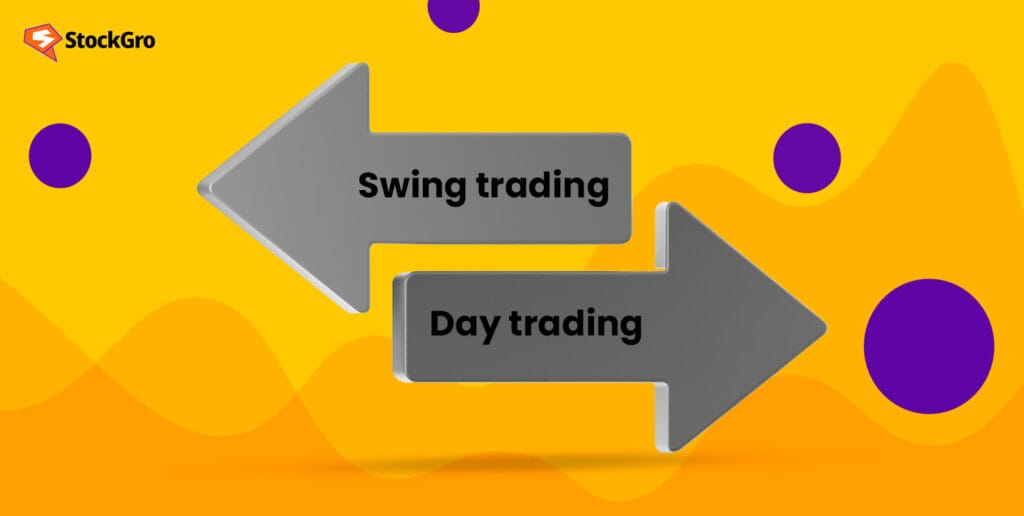
Traders in the stock market look for new strategies constantly to profit from the ever-fluctuating prices of stocks. Of the various techniques, swing and day trading are two short-term trading strategies traders often use.
In today’s article, we will learn in detail the features, benefits and risks of both types and compare intraday vs swing trading to understand which strategy yields better returns.
What is day trading?
Day trading, also called intraday trading, is a strategy where traders square off their positions on the same day. A trader who goes long on a stock squares it off by selling it before the market closes on the same day. Similarly, a trader who goes short on a stock buys it back before the market closes on the same day.
The objective behind intraday trading is to profit from price fluctuations that happen throughout the day. If the trader does not square off the position, trades will auto-square off by the end of the day at prevailing market prices.
Also Read: How does intraday trading work?
What is swing trading?
Swing trading is where traders hold positions longer than one day before squaring off. They usually hold positions overnight, for a couple of days or a few weeks. The objective here is to benefit from short-term price swings, hence the term swing trading.
Like intraday, swing trading uses short-term price fluctuations to book profits. However, the position is held for a longer duration here. Unlike intraday trading, swing trading time frames are more flexible, and it does not restrict traders about when they must square off.
Also Read: What is swing trading?
Intraday vs swing trading: What are the differences?
Examples
Let us consider a real-time example to understand the two concepts better.
A trader wishes to trade the shares of Jio Financial Services Ltd using the intraday strategy. He takes a long position on 11 March 2023, on 100 shares at ₹337 per share. He squares off his position on the same day at 2:00 PM by selling the shares at ₹359.65 per share, thereby making a profit of ₹22.65 per share. He makes a total profit of ₹2265 on this intraday trade.
Suppose he misses squaring off at ₹359.65, the shares square off automatically during the market close at the prevailing market price, which is ₹356.70 in this case. So, he earns a profit of ₹19.70 per share.
Let’s suppose the trader wants to adopt the swing trading strategy. He has been observing the shares of Jio Financial Services for the past few months and has noticed significant volatility. Based on his analysis, he goes long on 100 shares on 12 February 2024 at ₹271.45 per share. He sets a stop loss at ₹250 and waits for the share price to increase. On 11 March 2024, the shares reach ₹359.85, the highest for Jio’s shares, so far. He sells his shares and books a profit of ₹88 per share and earns a total profit of ₹8,800.
Differences
Now that we understand how the two strategies work, let’s assess the key differences between them:
- The time period is the first point of difference between the two. While day trading requires squaring off on the same day, swing trading allows traders to hold positions for a longer time.
- Day trading requires more focus as compared to swing trading. Consider the above example of day trading. If the trader missed squaring off at ₹359.65, his profits would reduce up to ₹3 per share. Swing trading, on the other hand, gives more freedom and flexibility to traders.
- Profit per transaction is low in day trading, but traders enter multiple transactions on the same day, making the overall profit considerably large. Since price changes are more significant, swing trading usually offers higher profits per transaction.
- The costs associated with day trading are relatively high compared to swing trading due to the increased number of transactions in day trading.
- Both strategies are risky. It is subjective to each trader as to which among them carries more risk. However, swing trading allows traders to take a more methodical approach and mitigate risks, while day trading has a concise window.
Also Read: What is expiry day trading?
Bottomline: Which among them is suitable for you?
Intraday and swing trading are both suitable strategies for traders who wish to earn profits in the short term. However, traders must acknowledge the risks involved in both these strategies before deciding to trade.
The choice between the two purely depends on each trader’s availability of time, money and the risk-reward objective. Day trading may be more suitable for those who can dedicate their whole day towards trading and are open to higher risks. Swing trading may suit those traders who wish to trade for a few minutes during the day with limited risk exposure.
